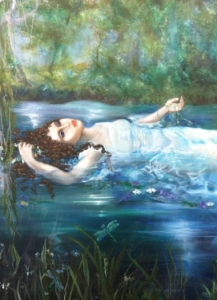Ophelia
Oil on canvas, 30” x 36”, 1996 $4500

There is a willow grows aslant a brook,
That shows his hoar leaves in the glassy stream;
There with fantastic garlands did she come
Of crow-flowers, nettles, daisies, and long purples
That liberal shepherds give a grosser name,
But our cold maids do dead men’s fingers call them:
There, on the pendent boughs her coronet weeds
Clambering to hang, an envious sliver broke;
When down her weedy trophies and herself
Fell in the weeping brook. Her clothes spread wide;
And, mermaid-like, awhile they bore her up:
Which time she chanted snatches of old tunes;
As one incapable of her own distress,
Or like a creature native and indued
Unto that element: but long it could not be
Till that her garments, heavy with their drink,
Pull’d the poor wretch from her melodious lay
To muddy death.
-Shakespeare
Queen Gertrude, Act IV, scene vii , Hamlet
Ophelia was Hamlet’s beloved, but ordered by her father Polonius to spurn Hamlet and return his love letters. Polonius thought that Hamlet was just trifling with his daughter and did not intend to marry her, though Queen Gertrude’s later remark at Ophelia’s funeral: “I hoped thou shouldst have been my Hamlet’s wife; I thought thy bride-bed to have deck’d, sweet maid, and not have strew’d thy grave.” would indicate otherwise. Hamlet also lamented Ophelia’s death and swore that he loved her, proclaiming to her brother Laertes as he leapt into her grave that he “loved her more than forty thousand brothers” could have.
Hamlet (and Polonius’ orders) broke Ophelia’s heart, and then Hamlet (accidentally) killed her father, and Ophelia, as I see it, became undone, as male authority and guidance had been what kept her in line, in a way she became free of them and reality and broke with reality to go into her own world of picking flowers, singing melodies, and letting nature take her away from the ongoing violence, murder, mayhem and cruelty back at the palace. In one scene, when she gives out flowers, she tells the Queen that she would have given her “some violets, but they all withered when my father died.” The audience of Shakespeare’s day was quite familiar with the different symbolisms of flowers, and they would have known that violets represented faithfulness. I believe Ophelia was utterly disillusioned and lost all her faith in Hamlet and in this world – because of the worldly and tragic happenings at the court, because she lost her father, because she lost Hamlet, and her world turned inward.
This painting was influenced by the pre-Raphaelites and by the work of John William Waterhouse, who himself painted Ophelia twice. I began this painting at 17, shortly after reading Hamlet for English class, and connected deeply with Ophelia’s sensitivity and feeling of not belonging to the world around her. As far as I know, this is the only serious, fine art depiction of Ophelia painted by a young woman, by a girl, as opposed to the middle aged men who tried to interpret her. I believe I bring to this interpretation a truly feminine and empathetic understanding of what it is to be a young woman overburdened and pressured by a society that ranks male judgment and authority as the source of female validation, to be a young woman who feels lost, foresworn, overwhelmed with emotion, and who finds solace and connection with nature.
Ophelia’s true madness was always in the shadow of Hamlet’s play madness, though I found it much more interesting and profound that his famous ditherings and indecision. Although it is tragic that her father’s authority pushed her away from Hamlet, and that Hamlet lied that he did not love her and treated her very badly, Ophelia’s death in this painting is a positive death- a mystical death, which is why I used a lot of blue and purple, although her death was supposed to be in a forest stream, where you would expect more brown and earthy colors. Dragonflies, insect that represent mystical connection with the spirit world, beckon her and welcome her, flowers and dragonflies providing comfort and beauty to counter the harshness.
Water represents emotion, change, loss, and has not definite shape, so it is not surprising that Shakespeare gives Ophelia a death in and by water. I wanted this painting to express Ophelia’s other sensual sweetness and other wordly quality. She is already a half-ghost before she dies, hardly in or of this world, and moving through her grief and despair into the unknown. Only by escaping this existence, through madness and death, was she able to be liberated and free from the male authority that pervaded her existence and blocked her from happiness. Ophelia is one with nature and her surroundings, she is watery, she is a mermaid, she is elusive and defiant.
Leave a Reply
You must be logged in to post a comment.